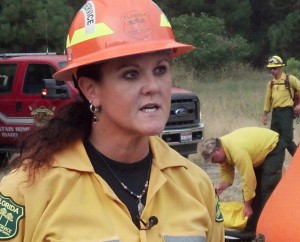
As a Wildfire Mitigation Specialist with the Florida Forest Service (FFS) for the last 7 years, Ludie Bond covers one of their 15 designated districts in Florida. The Waccasassa District comprises five counties: Alachua, Gilchrist, Levy, Marion and Putnam. She acts as the district’s public information officer, providing local and state media with information about wildfires, wildfire causes, wildfire prevention and fuel mitigation programs in the area. She also develops Firewise projects and Community Wildfire Protections Plans to lower the risk of wildfires and the effects of wildfires in communities determined to be at risk throughout the district.
Bond holds a Bachelor of Science in Public Relations and a Master of Forest Resources and Conservation from the University of Florida. Bond serves as a public information officer on one of the Type 2 Incident Management Teams with FFS and has responded to wildfire incidents throughout Florida and as far west as Texas, Montana, Utah and most recently Idaho.
The Florida Forest Service (at that time known as the Florida Division of Forestry) warned the Florida Highway Patrol that smoke would continue to be a concern during the overnight hours and could potentially impact both US Hwy 441 as well as I-75 to the west.
Fog was predicted that night, but what happened over the next few hours, no one could have predicted. The fog and smoke mixed in the ‘bowl’ that is Paynes Prairie creating what is now referred to as ‘super fog.’ Visibility along I-75 was reduced drastically to the extent that the stretch of interstate that runs through Paynes Prairie that had been clear for over an hour just before it was re-opened was blindingly immersed in the super fog the next minute. What resulted was a horrific pile up of cars and trucks resulting in over 20 injuries and tragically 11 fatalities.
From a public information perspective, the two primary agencies involved were the Florida Highway Patrol (FHP) and the Florida Division of Forestry (now the Florida Forest Service/FFS). That meant that myself as public information officer for FFS and the public information officer for FHP would be working together in ‘unified command’ with regards to the crisis communication function for the agencies we represented.
There are some critical points to why during our after-action review of this incident, we recognized that there were several keys to why the crisis communication techniques we implemented were effective.
Pre-established working relationship
We had worked together before. The PIO for FHP and I had been working together on wildfire smoke on the roadways issues for the last several years. We both cover some of the same counties, so the opportunities to develop methods of communicating consistent, credible and timely messages to the local media and public were already in place. It pays off during times of crisis when the working relationships are already familiar and comfortable.
Pre-established credible and trustworthy spokespersons
Both of us had also been PIOs for our agencies for many years. The media and public were used to seeing our faces — we were familiar. They were used to receiving information regarding smoke on the roadways and the status of wildfires from us in our coverage areas. They trusted that the information we disseminated was accurate, credible, and timely.
The media knew that we were the key points of contact in our coverage areas for information regarding incidents such as this. They also knew that we were ‘reachable’; that we gave out as much releasable information as possible on incidents. We were both known for answering our cell phones and returning phone calls right away.
We all know that the media WILL find a way to get the information they are tasked with obtaining, by any means necessary. It’s in our best interest to make sure they are obtaining that information from the most reliable and credible sources…us. This also greatly influences rumor control. Our pre-established working relationship with the local media played well as we began to encounter state, regional, national as well as international media as word of this tragic incident spread, which didn’t take long.
Establishing the key messages and methods of dissemination
We immediately determined what they key messages would be for each of us to focus on both with regards to the incident and with regards to the roles each of our respective agencies played in this tragedy and that we would communicate with compassion and empathy due to the tragic circumstances.
There was no question that FHP would comment on matters involving the traffic accidents and that FFS would comment on matters involving the wildfire. We would hold press conferences together and bring in the PIO from the Florida Department of Transportation (FDOT). The PIOs also held after action reviews daily to see what went well and what could have been handled better. We worked together even when the emphasis shifted away from the wildfire and more toward the traffic accidents. FFS and FDOT continued to offer support to our peer with FHP.
What are the lessons learned and how have things changed
After just about every incident, there are always lessons learned and opportunities to improve. The operations component of the agencies involved have since held regular meetings to better establish methods of communication and tactics. The PIOs have also held meetings to better establish the same objectives. Since our coverage areas overlap into other counties, involving our peers within our respective agencies, additional PIOs not only in our surrounding areas but throughout Florida have become active in the process to foster the types of working relationships that worked so well during our tragic incident that none of us saw heading our way.

















